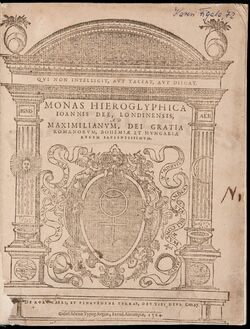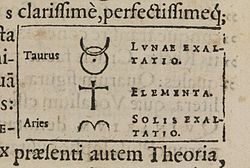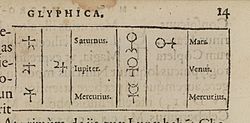Philosophy:Monas Hieroglyphica
 Frontispiece of the 'Monas Hieroglyphica' by John Dee, printed by Willem Silvius in Antwerp, 1564 | |
| Author | John Dee |
|---|---|
| Published | 1564 |

Monas Hieroglyphica (or The Hieroglyphic Monad) is a book by John Dee, the Elizabethan magus and court astrologer of Elizabeth I of England, published in Antwerp in 1564. It is an exposition of the meaning of an esoteric symbol that he invented.
Dee's Monas Hieroglyphica presents a complex emblem constructed from various astrological symbols, with elements of Latin wordplay, capitalization, spacing, and diacritics, rendering its interpretation challenging. The symbol is intended to embody a profound concept, representing the unity of all creation influenced by celestial forces. Dee believed that this symbol contained the essence of alchemical transformation and spiritual evolution, and by meditating upon it, he aimed to access hidden knowledge transcending linguistic barriers. In merging astrology, alchemy, mysticism, and metaphysics, the Hieroglyphic Monad serves as a visual manifestation of Dee's interconnected worldview.
Content
Understanding the text is difficult because of Dee's Latin wordplay, unexplained capitalization, odd spacing and diacritics.[1]
Meaning of the symbol
John Dee intended the Monad to incorporate a wide range of mystical and esoteric concepts. This complex symbol was meant to symbolize the unity of all creation, influenced by astrological and planetary forces. Dee believed it held the essence of alchemical transformation and spiritual growth. By meditating on the Monad, he thought to gain insights into hidden knowledge about the universe, transcending language barriers and tapping into profound truths. Overall, Dee's intention was to encapsulate his interconnected worldview, combining elements of astrology, alchemy, mysticism, and metaphysics.
Reception and influence
The book received little notice in English sources, though it is praised in the 1591 edition of George Ripley's The Compound of Alchymy[2] as well as in Elias Ashmole’s Theatrum Chemicum Britannicum (1652).[3] A number of references appear in other languages, for example, Jean-Jacques Manget’s Bibliotheca Chemica Curiosa (1702)[4] and Lazarus Zetzner’s Theatrum Chemicum (1602; 1659–1661); the latter reproduces the Monas Hieroglyphica in its entirety.[5]
Gerard Dorn's Judgement of the Spagiric Art of Johann Trithemius[lower-alpha 1] contains terms and phrases based on the Monas, and his commentary on the Tractatus Aureus references the words ("Vulgaris, Hic, Oculus caligabit, diffidetque plurimum") accompanying a figure in the Monas,[6] saying "with the eyes of the mind, for the vulgar eye, as John Dee of London says, will here find fault and be most distrustful."[lower-alpha 2] Peter Forshaw suggests that it is likely that Dorn's use of the same line and circle figure in his Monarchia Physica or Monarchia Triadis, in Unitate (1577)[lower-alpha 3] is a reference to the figure in Dee. It is also reproduced in the English logician, mathematician, and medic Thomas Oliver’s De Sophismatum praestigijs cauendis admonitio (1604).[7] His further comments in the work suggest that he was also familiar with Dee’s "Mathematicall Praeface" to Billingsley’s translation of Euclid’s Elements of Geometrie (1570).[8]
Giulio Cesare Capaccio refers to the Monas in his Delle imprese (On devices) (1592), paraphrasing content from the preface and mentioning the 'recondite Kabbalistic philosophy’ of 'Giovanni Dee da Londino.'[9] Cesare della Riviera includes Dee's glyph, without attribution,[10] in his Il Mondo Magico de gli Heroi (1605).[11] The glyph is also reproduced in the Amphitheatrum sapientiae aeternae (1595; 1609) of Heinrich Khunrath, where it is used in a more alchemical context.[12]
The glyph was adopted by the Rosicrucians and appears on a page of the Rosicrucian manifesto Chymical Wedding of Christian Rosenkreutz (1616), beside the text of the invitation to the Royal Wedding given to Christian Rosenkreuz, who narrates the work.[citation needed] Frances Yates notes that Dee's influence later "spread to Puritanism in the New World through John Winthrop the Younger, an alchemist and a follower of Dee; Winthrop used the 'monas' as his personal mark."[13]
Publications
- Dee, John (1564). Monas Hieroglyphica. Antwerp: Willem Silvius.
- Dee, John (1602). "Monas Hieroglyphica". in Zentner, L.. Theatrum Chemicum. II (first ed.). pp. 203–43.
- Dee, John (1659). "Monas Hieroglyphica". in Zentner, L.. Theatrum Chemicum. II (2nd ed.). pp. 178–215.
- Dee, John (2003). Monas Hieroglyphica (facsimile ed.). Kessinger Publishing Co. ISBN 0-7661-4744-4.
English translations
- Dee, John (1947). The Hieroglyphic Monad. John M. Watkins.
- Josten, C. H. (1964). "A Translation of John Dee's "Monas Hieroglyphica" (Antwerp, 1564), with an Introduction and Annotations". Ambix XII (2–3): 84–221. doi:10.1179/000269864790223101.
- Dee, John (1975). The Hieroglyphic Monad. Weiser Books. ISBN 1-57863-203-X.
- Dee, John (2021). Monas Hieroglyphica. Ouroboros Press.
See also
- Agrippa code
- Alchemical symbol
- Astrological symbols
- List of occult symbols
- Magical formula
- Monism
- Renaissance magic
References
Notes
- ↑ G. Dorn, "De Spagirico Artificio Io. Trithemii sententia," in Zetzner (1659–1661), vol. 1, pp. 388–99, on 393.
- ↑ Manget, Bibliotheca Chemica Curiosa, I, 409: "In his autem numeris tacitè occultari sapientum pondera, author non obscure abstruere, videtur, praecipue in septenario, qui numerus sacer habitus fuit antiquitus, utpote in quo plurimum sapientiae sit reconditum: sed vim & virtutem ejus mentis oculis contemplari debes, Vulgaris enim hic oculus, teste Joanne Dee Londinensi, castigabit diffidetque plurimum."
- ↑ G. Dorn, "Monarchia Triadis, in Unitate, Soli Deo Sacra," in Dorneus (1577), 65-127, on 71.
Citations
- ↑ Turner & Burnes (2007).
- ↑ Ripley (1591).
- ↑ Ashmole (1652), pp. 334, 478-84.
- ↑ Manget (1702).
- ↑ Forshaw (2005), p. 248.
- ↑ Forshaw (2005), p. 250.
- ↑ Forshaw (2005), pp. 250-251.
- ↑ Forshaw (2005), p. 251.
- ↑ Campbell (2012).
- ↑ Forshaw (2005), p. 257.
- ↑ della Riviera (1986), pp. 34-35.
- ↑ Forshaw (2005), p. 259.
- ↑ Yates (1972), p. 286.
Works cited
Primary sources
- Ashmole, E., ed (1652). Theatrum Chemicum Britannicum; containing severall poeticall pieces of our famous English philosophers, who have written the Hermetique Mysteries in their owne ancient language. Faithfully collected . . . with annotations thereon, by E. Ashmole. London.
- della Riviera, C. (1986). Il Mondo Magico de gli Heroi, Edizione del 1605, Introduzione di Piero Fenili. Rome: Edizioni Mediterranee.
- Dorneus, G., ed (1577). Aurora Thesaurusque Philosophorum, Theophrasti Paracelsi, Germani Philosophi, & Medici prae cunctis omnibus accuratissimi. Basel.
- Khunrath, H. (1609). Amphitheatrum sapientiae aeternae solius verae: Christiano-Kabalisticum, divino-magicum, nec non physico-chymicum, tertriunum, catholicon. Hanau.
- Manget, J.-J., ed (1702). Bibliotheca chemica curiosa, seu rerum ad alchemiam pertinentium thesaurus instructissimus. Geneva: Chouet.
- Ripley, G. (1591). The Compound of Alchymy. London: Thomas Orwin.
- Zetzner, L., ed (1659–1661). Theatrum Chemicum, praecipuos selectorum auctorum tractatus de chemiae et lapidis philosophici antiquitate, veritate, iure, praestantia et operationibus, continens, 6 vols.. Strasbourg.
Secondary sources
- Campbell, A. (2012). "The reception of John Dee's Monas Hieroglyphica in early modern Italy: The case of Paolo Antonio Foscarini (c. 1562–1616)". Studies in History and Philosophy of Science Part A 43 (3): 519–529. doi:10.1016/j.shpsa.2011.12.010. ISSN 0039-3681. Bibcode: 2012SHPSA..43..519C.
- Forshaw, P. J. (2005). "The Early Alchemical Reception of John Dee's Monas Hieroglyphica". Ambix 52 (3): 247–269. doi:10.1179/000269805X77772.
- Turner, Nancy; Burnes, Teresa (2007). "A Partial Re-Translation of John Dee's Monas Hieroglyphica - Nancy Turner and Teresa Burnes". Journal of the Western Mystery Tradition 2 (13). http://www.jwmt.org/v2n13/partial.html. Retrieved 9 August 2023.
- Yates, Frances (1972). The Rosicrucian Enlightenment. London and Boston: Routledge and Kegan Paul Ltd.
Further reading
- Cavallaro, Frederico (2006). "The Alchemical Significance of John Dee's Monas Hieroglyphica". in Clucas, Stephen. John Dee: Interdisciplinary Studies in English Renaissance Thought. Springer Netherlands. p. 159 ff. ISBN 978-1402042461.
- Clucas, S. (2010). "Pythagorean Number Symbolism, Alchemy, and the Disciplina Noua of John Dee's Monas Hieroglyphica". Aries 10 (2): 149–167. doi:10.1163/156798910X520575.
- Clucas, S. (2017). "The Royal Typographer and the Alchemist: John Dee, Willem Silvius, and the Diagrammatic Alchemy of the Monas Hieroglyphica". Ambix 64 (2): 140–156. doi:10.1080/00026980.2017.1356972. PMID 28795645. https://eprints.bbk.ac.uk/id/eprint/19502/1/Clucas_pre-proof%20version.pdf.
- Clulee, N. H. (2005). "The Monas Hieroglyphica and the Alchemical Thread of John Dee's Career". Ambix 52 (3): 197–215. doi:10.1179/000269805X77763.
- Craven, J. B. (1975). "John Dee's Hieroglyphic Monad as Symbol of Unity". Ambix 22 (2): 97–102.
- Gingerich, W. (2010). "The Hieroglyphic Monad: Politics and Esotericism in John Dee's Monas Hieroglyphica". Aries 10 (2): 149–175.
- Harkness, D. (1999). "John Dee's Hieroglyphic Monad: Language, Writing, and Revelation.". Aries 1 (1): 49–61.
- Mertens, M. (2017). "Willem Silvius: "Typographical Parent" of John Dee's Monas Hieroglyphica". Ambix 64 (2): 175–189. doi:10.1080/00026980.2017.1355594. PMID 28782458.
- Norrgrén, H. (2005). "Interpretation and the Hieroglyphic Monad: John Dee's Reading of Pantheus's Voarchadumia". Ambix 52 (3): 217–245. doi:10.1179/000269805X77781.
- Szonyi, G. E. (2010). John Dee's Occultism: Magical Exaltation Through Powerful Signs. State University of New York Press. ISBN 978-0791484425.
- Szulakowska, U. (2000). The Alchemy of Light: Geometry and Optics in Late Renaissance Alchemical Illustration. Boston: Brill. ISBN 978-9004116900.
- Vanden Broecke, S. (2017). "The Ideal of a Knowledge Society in Dee's Monas Hieroglyphica (1564) and Other Productions by Willem Silvius". Ambix 64 (2): 157–174. doi:10.1080/00026980.2017.1353230. PMID 28782424.
External links
- Monas Hieroglyphica at Esotericarchives.com
- Monas Hieroglyphica at the Internet Archive
- Monas Hieroglyphica at the Library of Congress
 |



